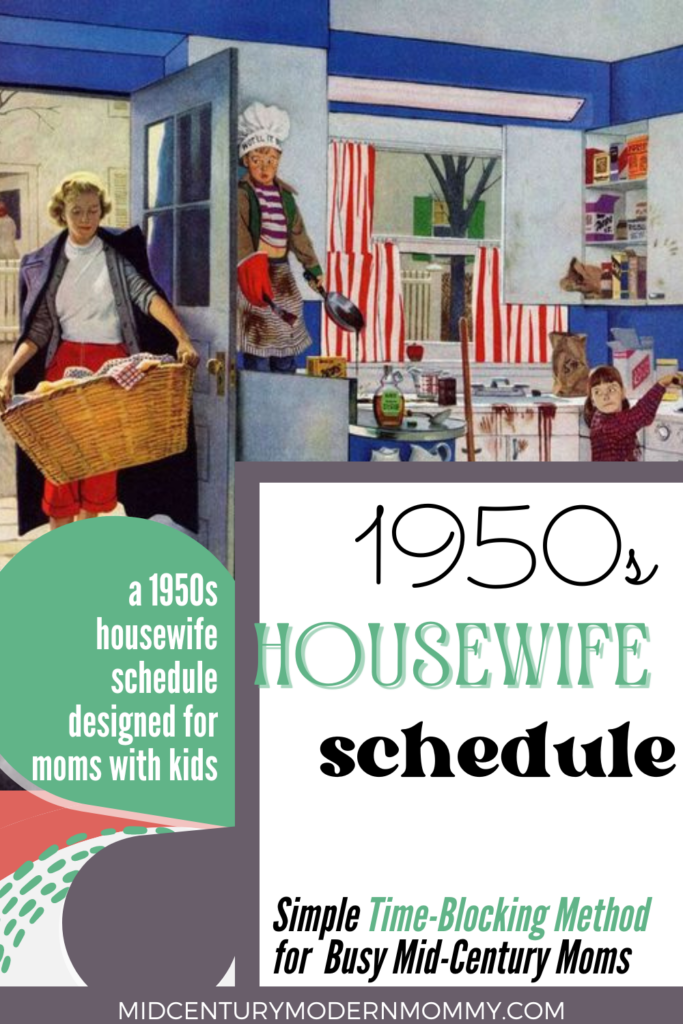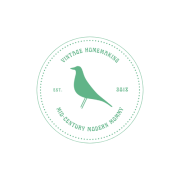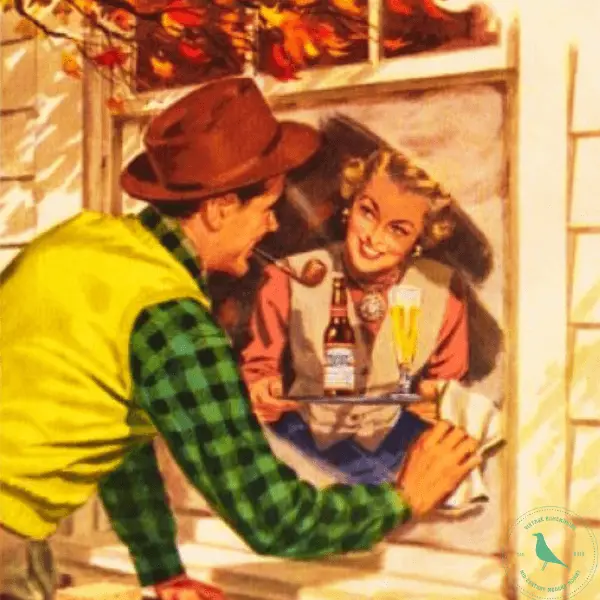Are you struggling to manage your household with three young children? I used to be in the same boat. My life was a disaster – my house was a mess, my children were always late for school, and I never had enough time for myself. It wasn’t until I discovered vintage secrets for managing my home that everything changed. In this guide, I’ll share with you a simplified schedule that you can use to guide your days and some specific information on how to run your home like a pro, just like I did.
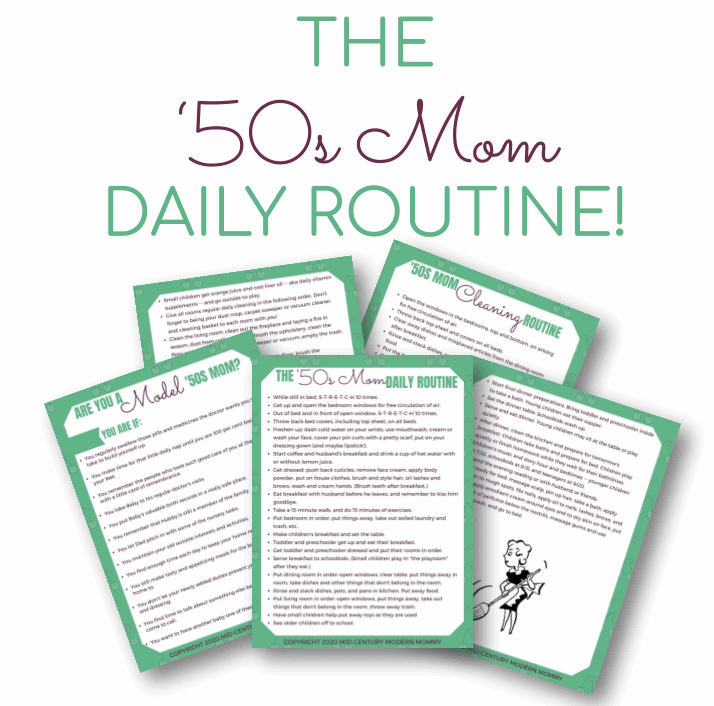
Get Our Mid-Century Mom Daily Routine FREE!
This post contains affiliate links. If you click a link and make a purchase, I may receive, at no additional cost to you, a small commission. Find out more on my Disclosures page, and thank you so much for your support!
The Importance of Having a Schedule
In the 1950s, housewives were expected to manage their households efficiently, which is why having a schedule was crucial. Having a schedule is essential for managing your household like a pro. It helps you stay organized, plan ahead, manage your time effectively, and avoid wasting time on unimportant tasks. By incorporating a schedule into your daily routine, you can become a more efficient and effective housewife, just like those from the 1950s.
Here are some other reasons why a schedule is important:
Stay Organized and On Track with Your Tasks
A schedule helps you stay organized and on track with your tasks. By planning out your day, you can ensure that you accomplish everything you need to. Without a schedule, it’s easy to get sidetracked and forget important tasks.
Plan Ahead and Be Prepared for Any Unexpected Events
One of the benefits of having a schedule is that it allows you to plan ahead and be prepared for any unexpected events. For example, if you know you have a doctor’s appointment in the afternoon, you can plan your tasks around it to ensure that you still accomplish everything you need to for the day.
Manage Your Time Better and Avoid Wasting It on Unimportant Tasks
A schedule helps you manage your time better and avoid wasting it on unimportant tasks. By prioritizing your tasks and allocating specific amounts of time to each one, you can ensure that you’re making the most of your time. This way, you can focus on the tasks that are most important and avoid spending too much time on tasks that aren’t as essential.

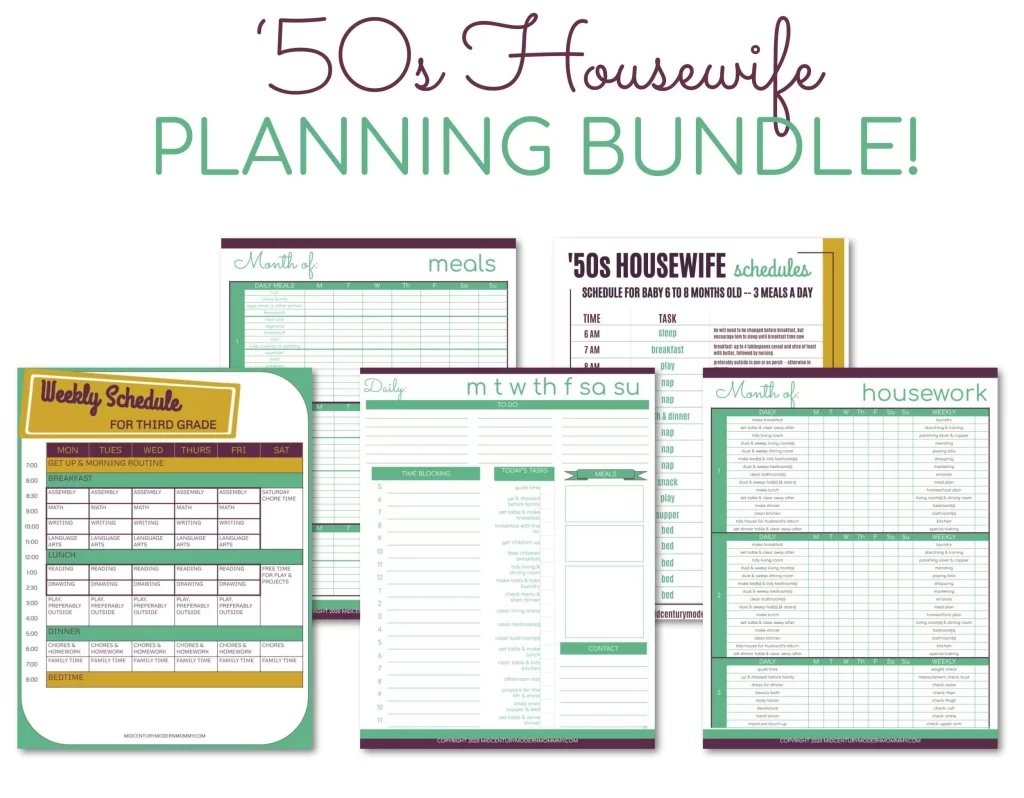
A Simple 1950s Housewife Schedule
Here’s a simplified schedule that a 1950s housewife would follow, which is essentially time-blocking. Time-blocking is a simple technique that involves breaking your day down into specific blocks of time, each of which is dedicated to a specific task. In this case, each routine block contains a few tasks. You want to focus on getting those tasks done in those blocks, but other than eating or sleeping, you don’t need to let any of those tasks slide into another time block. So, if you have a horrendous day with all 3 kids getting sick at once, then you can just let some of the cleaning that you don’t get to during the mid-morning block slide. It will come around to be done again.
That’s why you need a schedule as a housewife. With a schedule, all of those repetitive, seemingly endless tasks will come around again and again. Then, if you want to choose to miss doing some of your work because you want to go on a picnic with the family, everything will be ready to be spontaneous (because you’ve been doing your work up until now and you’re all caught up), and you can go off with a light heart, knowing that you’ll be able to catch up easily by just waiting until the next day or week (or season) when the task comes around again.
In fact, you can even take one of the 1950s Housewife Routines that is a list of tasks and just put the tasks into the routine blocks where you want them!

Morning Routine
Wake up at 6:00 am and start preparing breakfast for the family.
As a vintage housewife, waking up early is crucial for having enough time to get dressed, fix your hair and makeup, and still have time to prepare breakfast and get the children ready for school. By waking up early, you can establish a routine that allows you to start your day calmly and with purpose. This can help reduce stress and set a positive tone for the rest of the day.
Start your day by getting out of bed, throwing back the covers to air the bed (if no-one is left in it!), opening the windows to air the room and STRETCH, and freshening up! Here’s what The Bride’s Reference Book from 1948 said about a freshening-up routine:
“If you are a Bride with a maidless kitchen, learn to get up gracefully in the morning. Give a few quick brushes to smooth your hair — tie it back with a ribbon rather than fussing with curls — a dash of cold water on your face, toothbrush drill, and a light application of lipstick gives you confidence for grappling with coffee pot and orange squeezer. Ten minutes should do it. Don’t weaken and start the coffee first, or you will soon cease to bother going back to ‘pretty-up.’ There lies the downward path from beautiful Bride to dishevelled wife.”
However, I already have children. So my morning routine incorporates the Housewife Beauty Routine from the 1955 Constance Hart’s Handbook of Beauty.
Tips for Making Breakfast
The second part of this is preparing breakfast for your family. Here are some of my tips from years of learning how to get a proper square meal on the table every morning.
- Post the breakfast menu so everyone can see it. Especially you right after you get up, so you don’t have to think AT ALL.
- Keep the coffee maker, coffee, and measuring spoon together.
- Arrange a variety of cereals in one place, together with cereal bowls. Or, if you serve hot cereals, keep them together with a measuring scoop, with toppings together and ready to put out at the tables.
- Assemble milk, cream, and other refrigerated breakfast items together toward the front of the refrigerator.
- Keep an assortment of canned juices and fruit sections chilling in the refrigerator. Mix different ones together for flavor interest. If you use frozen juices, shake them up ahead of time and keep them covered in the refrigerator. Keep covered containers of stewed dried fruits in the refrigerator to mix with or replace the fruit sections.
- Hang frequently used utensils such as the pancake turner, egg beater, and meat fork near the range.
- Plan menus that involve a minimum of planning or thinking in the morning. Know how to make scrambled eggs and toast, pancakes, fried eggs, poached eggs, boiled eggs, oven-baked bacon, and sausage patties from scratch, and also practice a few of your family’s favorite breakfasts until you can do them even when you haven’t gotten enough sleep.
- Ask each breakfaster to clear his place, and scrape, rinse, and stack his dishes in the kitchen.
- Make use of electrical appliances: a coffee maker that will keep the coffee hot, a saucepan for cooking eggs, and a skillet for bacon and pancakes.
- Look for new kinds of bread and muffins to add interest to breakfast.
- Keep an assortment of jams and jellies handy and in one place, preferably near the butter, salt, and pepper, for easy table setting.
- Keep your breakfast linens together in the dining room for easy table setting. (I also keep a separate set of dishes for breakfasts and lunches, which I keep together in the china closet.)
Wake up your children and help them get ready for school.
As a mother, you want to ensure that your children are well-fed and dressed appropriately for school. Here is the basic morning routine for a schoolchild in the 1950s:
Out of bed, say your prayers, throw back the bedcovers, and into the bathroom –
- Drink one big glass of water.
- Brush your teeth carefully.
- Wash your face gently but thoroughly with a clean washcloth, a good mild soap, and plenty of warm water. Don’t forget the back of your neck and your ears. Wash hands.
- Wet, towel dry, and comb your hair into place, or brush out the nighttime tangles and comb carefully into place, pinning securely.
- Dress in your school clothes, hanging up your pajamas and bathrobe carefully.
- Go to breakfast.
- Return to your room. Make your bed and put away your pajamas.
- Wash your face and hands, and comb your hair. Collect your school things.
- Take a last look, to be sure you are impeccable from top to toe.
I explain how to teach your children to follow these routines in my article on schedules for preschoolers.
Serve breakfast for the family at 8:00 am.
Having a set time for breakfast is one of those Domestic Spices for a Happy Home from the 1930s that I like to talk about! It sets expectations for the day and helps everyone start off on the right foot. And, it can be a great opportunity for families to spend time together before the day gets busy.
Here’s a list of vintage tips for making breakfast time enjoyable and stress-free:
- Plan ahead by preparing for tomorrow’s menu the night before
- Keep all the supplies for setting the breakfast table together in a convenient place to make table-setting easy.
- Encourage children to help with simple tasks like setting the table or pouring drinks
- Keep breakfast simple with easy-to-make dishes like scrambled eggs or oatmeal on days when the family is busy
- Play some upbeat music to set the mood for the day and finish up with family prayers

Mid-Morning Routine
Get your kids off to school, or sitting down for homeschool, by 9:00am
I cannot stress enough the importance of using a curriculum that emphasizes the development of skills. It’s essential that children learn how to learn, and that means focusing on developing core competencies such as critical thinking, problem-solving, and effective communication.
I’ve found that by providing my children with a curriculum that prioritizes these skills, they have been able to become self-learners, even after just finishing second grade. It’s reminiscent of the one-room schoolhouse approach, where students of all ages learned together and progressed at their own pace.
By using resources such as McGuffey’s Readers and Ray’s Arithmetic, my kids have been able to develop their reading, writing, and math skills in a way that is challenging but also tailored to their individual abilities. This approach has not only fostered a love of learning in my children, but has also set them up for future academic success.
There are 2 resources that I recommend for this: Robinson Curriculum, especially at younger ages, and Classical Liberal Arts Academy, to supplement with a truly classical learning in middle school and high school. These are both very Christian resources, but I find that good learning methods can be adapted to any culture or religion.
Another thing that I find crucial to keeping my household running smoothly is my 1940s cleaning schedule. With eight kids and a busy schedule, his schedule has been a lifesaver for me.
All of the tasks on the list can be completed by noon, which allows me to focus on other things throughout the day. (And if your cleaning takes longer than that, it’s a sign that you may want to declutter and simplify your home.)
In traditional homes, there were plenty of clear surfaces, and items were often hidden away, which made cleaning much easier. A clean house is not only aesthetically pleasing but also good for your mental and emotional health. It’s amazing how much more productive and energized I feel when my home is clean and organized.

Afternoon Routine
Prepare lunch for the family at 12:00 pm
At 12 pm, it’s time for lunch. I like to keep things simple with sandwiches and soup. If your kids go to school, then you definitely need to plan lunch, or you will find yourself forgetting things and trying to work in a morning fog. So make a plan, including menus, so that lunches can be packed easily while you are also making breakfast. Here are some tips for having a Hot Lunch every day:
- Plan ahead: Just like with any meal, planning is key. Think about what you want to make and what ingredients you need. Make a list and shop ahead of time to avoid scrambling at the last minute.
- Use leftovers: Don’t be afraid to repurpose leftovers from dinner the night before. Soups, stews, and casseroles make great hot lunches and are easy to reheat.
- Embrace the vintage: Take a page from your grandmother’s cookbook and get creative with sandwiches and hot dishes. Vintage cookbooks are PACKED with interesting ideas for sandwich fillings and soups that you have probably never tried.
- Make it fun: Lunch should be pretty and fun, even if it is just you or you and your babies at home.
Because this is the main meal of the day for my littles, I usually have leftovers from our family. dinner from the night before that I save to make nursery dinner. You can read more about how I manage nursery meals if you also have little ones. I also include menus for breakfast and lunch in my meal plan, because otherwise, it is too easy to skip lunch.
Part of gracious living is taking the time to take care of yourself, even when you are at home by yourself. This means stopping to eat a pretty meal, washing the dishes, and taking care of daytime beauty tasks, like prettying up. It might seem like a small thing, but taking a break and tending to your physical appearance can make a big difference in your mental and emotional wellbeing. Don’t neglect yourself in the hustle and bustle of daily life, especially when you are at home.
Attend to any necessary errands
This is my time for my own activities. It isn’t just about running errands, I also spend this time sewing, reading, or meeting friends. I have 2 hours EVERY DAY that I can devote to things I want to do.
When we are at home, my children spend this time napping or reading. Usually, this is all done in separate rooms so that no one can get too loud. I live all away out of town, so I tend to group my errands into one day a week, so I don’t have a lot of useless car time. Here are some tips that I use to manage errands efficiently:
- Plan ahead by creating a schedule for errands and setting aside dedicated time slots.
- Group similar tasks together to save time and energy, such as grocery shopping and picking up dry cleaning.
- Use technology to your advantage, such as ordering groceries online or mapping out the quickest route.
- Be flexible and adaptable, but also stick to your plan as much as possible.
- If you have children with you, review the “in store” and “in public” behavior and rules in the car before every stop.
- Take breaks and rest when needed to avoid burnout and exhaustion.
Another thing that I do that is very vintage and gracious living is to change into a day dress or street suit for going out and about, then wash my face, and completely redo my hair and makeup. I also have my children do this complete change and washing up before we go anywhere. I have my children keep their “school” clothes and “play” clothes separate, so that they have something nice to wear when we go out.
Pick up your children from school at 3:00 pm and prepare snacks for them
Obviously, I don’t have to pick up my kids from school, but I do have them clean up after homeschooling, and then eat a snack.
When it comes to after-school snacks, I like to keep it simple with classic options like cookies, biscuits, graham crackers, or bread with jam. I always accompany the snack with a glass of milk, and sometimes, I throw in a piece of fruit for some extra sweetness and nutrition. In summer, I serve a lot of frozen juice popsicles.
I find that providing my children with some unsupervised time to move their bodies and play is both necessary and beneficial. Children, especially after school, need to move their bodies and be unsupervised more than they need to do homework! So my children have from about 3 to about 6 to escape the confines of their homeschool and be outside. Mid-century elementary kids would have spent the time playing with other neighborhood kids, and teens would have spent this time in clubs and sports, or with friends. So I consider this to be socializing time well spent in play.
Prepare for your evening at 3:00 pm
This is the routine that I follow from around 3 until dinner:
First, I start dinner for the family at around 3, just after the children have had an afternoon snack. This gives me a good 2 hours of rest, sewing, etc. between lunch and starting dinner.
By 4:00, dinner is well underway. At this point, I start tidying the house. (This suggestion is part of the Good Wife’s Guide. Since the pandemic, my husband works from home, but I still try to follow the suggestions.) At 4:30, I call the preschoolers from play, and they take their baths. We have a whole routine for this, teaching orderliness, which I also got from the Better Homes and Gardens Baby Book. While they are in their baths, I put together the nursery supper.
Baths are basic — lots of Ivory soap and Johnson’s Baby shampoo — and after baths, the little ones are dressed in clean pajamas, bathrobe, and slippers for nursery supper.
The hour for our nursery supper is 5:00 pm so that the little ones can eat and go to bed by 7:00. The latest bedtime that they have is 8 on special occasions until they are 6 and in 1st grade. (One of the perks of getting older in our family.) They all eat in the kitchen. I putter around, preparing aperitifs and appetizers, and finishing the dinner. This gives me time to help those who need it, and also to work with my ARFID child.
Usually, the children are finished by 5:30. This gives me a half-an-hour to set the table and spend time socializing with my husband. So at 5:30, I set the children to read alone in their rooms or quietly together. I make the house quiet in the evening for my husband to transition back to family life. He has moderate misophonia, and the quiet time is helpful to him. Plus, time for the parents to be together teaches the kids that OUR marriage is more important to the family than they are. (That sounds harsh, but by putting my marriage as a priority for the foundation of the family, my kids feel more secure and behave better.)

Evening Routine
Serve dinner and clean up afterwards at 6:00 pm.
Then at 6:00, everyone sits down to the family dinner.
Setting the table, serving dinner, and cleaning up afterward are important parts of our family’s routine. I like to keep things simple and elegant, so I use vintage-inspired tableware and linens. Here’s how I go about it:
- First, I lay out the tablecloth and place mats.
- Next, I set the plates, glasses, and silverware in their designated spots.
- I like to add a centerpiece or some flowers to brighten up the table and make it feel more special.
- Once the table is set, it’s time to serve dinner. I try to make healthy, homemade meals that are easy to prepare.
- After dinner, we clear the table and wash the dishes together. I find that this is a great way to bond as a family and teach my children about responsibility.
To make dinner time enjoyable and stress-free, here are some tips that have worked for us:
- Get the kids involved in meal planning and preparation. This not only helps to teach them valuable life skills, but it also encourages them to try new foods.
- Play some background music to create a relaxing and pleasant atmosphere.
- Avoid screens and distractions during dinner time. Instead, use this time to connect with your family and have meaningful conversations.
- Make dinner a special occasion by setting the table and using your best dishes.
- Finally, don’t stress too much about making a perfect meal. The most important thing is that you are spending time together as a family.
With the little ones when they are babies, I usually put them down to sleep during our family dinner, or Papa holds the baby on his knee. But by 12 months, they are participating. Each child gets some bread-and-butter and some milk, or a few spoonfuls of dinner. They sit and practice good manners, and listen to Mama, Papa, and the older siblings discuss all sorts of topics (most of the time we end up on philosophy and physics for some reason).
Having a set time for dinner is important because it helps to establish a routine and a sense of structure in our daily lives. By having a consistent dinner time, we know when to expect to sit down and eat together as a family. This also helps to avoid conflicts with other activities or schedules. In addition, having a set time for dinner can improve our digestion and overall health. Eating at regular times helps to regulate our metabolism and keeps our bodies in sync with our natural circadian rhythms. Overall, having a set time for dinner is a simple but effective way to improve our family’s health and well-being.
Spend time with the family, helping with homework or playing games at 7:00 pm.
Dinner is mostly over at about 7:00. The little ones brush their teeth and head to bed. I read to them and sing to them, they say their prayers, I tuck them in, and then I head back to the bigger kids and teens.
This is when we spend quality time as a family, working on hobbies, doing homework, or playing games. One thing that we try to do is to have a weekly game night, where we play classic board games like Monopoly or Scrabble. This can be a fun way to bond as a family and make memories together.
I also like to work on hobbies at this time. For example, if we are watching a show, I will usually be crocheting or knitting while I watch.
Help your children get ready for bed and read bedtime stories at 8:00 pm.
They don’t need much here, other than reminding. Here’s the basic bedtime routine that my school-age and older kids follow before bed:
GOOD-NIGHT!
Out of your clothes and into the tub –
- Coat yourself thoroughly with a susdy lather, and don’t spare the elbow grease. Rinse well, doing face separately with water from the faucet.
- Rub yourself dry, so that you tingle all over and chest and back turn a healthy pink.
- Don’t forget the deodorant under your arms.
- Give your crowning glory a good swishing with the brush, dampen ends and pin up curls.
- Brush teeth carefully.
- Down with a nice, long glass of water – and so to bed.
This routine comes from the October 1946 issue of Good Housekeeping, by the way. It’s meant for teen girls, but it works excellently as a bedtime reminder for any age that can take a bath alone.
I read to the younger ones, and my children usually sit and listen until they are in high school or so. We usually have family prayers now; it’s a big thing for the little ones when they get old enough to participate. The teens can stay up until 9 or 9:30, but they have to keep to themselves so that I can get my things done.
Clean the Kitchen and Prepare for the Next Day at 9:00 pm.
Most of the after-dinner cleaning is taken care of by the older kids and teens in the 15 minutes or so while I am putting the littlest children to bed at 7. But now is my time to come to the kitchen, review and prep tomorrow’s meals, and make everything clean and pretty.
Then it’s off to the living room, where I usually have about an hour to work on my hobbies or read. My husband and teenagers are usually watching something and working on something, or playing video games. Fortunately, we follow the recommendation in America’s Housekeeping Book when it comes to tidying in the evening:
“It does mean that each person should be thoughtful enough to put away school books and papers, playing cards, sewing or the stamp collection, as the case may be, when work or play is over. If every one helps by picking up newspapers, returning magazines to table or rack, and emptying ash trays just before bedtime each evening, the homemaker will have just that much less to do during the busy hours
of the next morning. And the living room will present a serene face to the earliest caller.”
Bedtime at 10:00 pm.
Around 9:30, I turn off all my screens and start my bedtime routine. I usually finish up with a novena or a chaplet and journal in bed before I go to sleep.
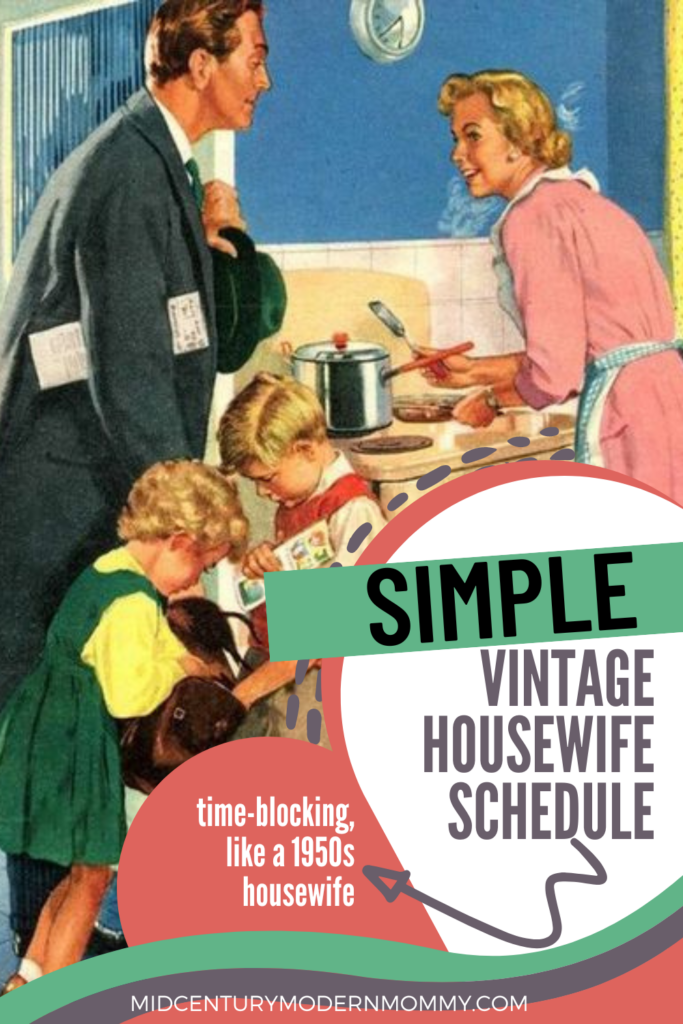
Make Your Own 1950s Housewife Schedule
Here are some tips for creating your own 1950s housewife schedule based on my experience:
- Start with a routine that works for you and your family: Everyone’s routine will look a little different depending on their needs and preferences. Take some time to think about what tasks need to be accomplished in a day and what times work best for your family. Consider factors such as school and work schedules, meal times, and after-school activities.
- Make a task list: Once you have a rough idea of your routine, make a list of all the tasks that need to be accomplished in a day. You can’t do the work if you don’t know what the work IS!
- Follow a timetable: To help stay on task, allocate a specific amount of time for each task. This will help you stay focused and prevent you from getting sidetracked. I use a 1940s cleaning schedule to divide up my task list and assign tasks to different blocks of time.
- Stay organized: Keeping a tidy and organized home can help reduce stress and increase productivity. You can’t clean if you don’t tidy first. And a vintage home is not necessarily one crammed with stuff. Only fill your home with things that you love.
- Get the family involved: Don’t be afraid to delegate tasks to other members of the family. Children can help with tasks such as folding laundry or setting the table. Vintage children always had chores, which they were expected to complete each day as well as on Saturday mornings.
By following these tips and using the sample 1950s housewife schedule as a guide, you can create a routine that works for you and your family. Remember to be flexible and make adjustments as needed. With a little bit of planning and organization, you can create a happy and stress-free home.

Get Our Mid-Century Mom Daily Routine FREE!

Resources
Constance Hart’s Handbook of Beauty
Good Housekeeping Magazine, October 1946
